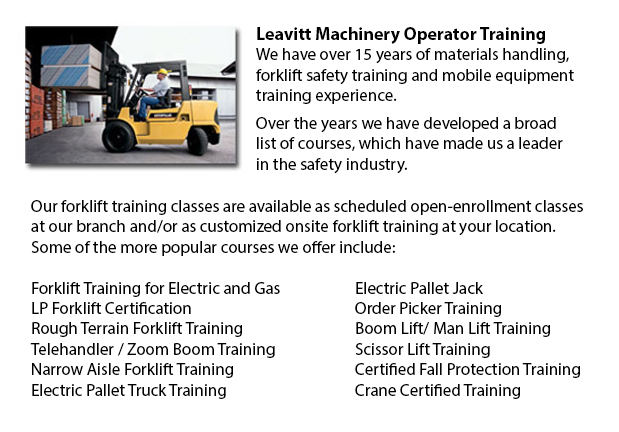
Rough Terrain Forklifts Training Ottawa - There are actually two distinctive categories of forklifts within the material handling market, the industrial model and the rough terrain model. Rough terrain lift trucks first came on the market in the 1940's and were primarily utilized on rough surfaces, best for places where no covered roads were existing, like construction sites and lumberyards.
Typically, nearly all rough terrain lift trucks are run on a propane, diesel or gas powered internal combustion engines with a battery used for power. A number of suppliers are playing with rough ground forklifts that make use of vegetable matter and run from ethanol. Large pneumatic tires with deep treads typify these lift trucks to allow them to clutch onto the roughest ground type devoid of any slippage or drifting.
Many of the first designs of rough terrain forklifts had the capability to haul in excess of 1000 lbs, via blades that could run beneath the item, haul it slightly and shift it to a different site. After ten years on the market, all terrain lift trucks were augmented with additional hauling muscle, increasing the potential cargo to more than 2000 lbs. In the 1960's telescoping booms were added, permitting them to stack resources a great deal higher than in preceding years. The telescoping model feature is a staple of nearly all all terrain forklifts today. Present styles are capable of handling well over 4000 lbs due to the continuous enhancements through the years. Telescoping capability has additionally improved with some models reaching a height of 35 feet. Operator safety has also become a focus with several rough terrain forklifts now built are equipped with an enclosed cab for the operator, versus the older open air seating capacity.
The rough terrain forklifts accessible today work equally as well on paved floors as on unpaved surfaces. These all terrain lift trucks are being marketed for their versatility permitting firms to transport items from outside the plant to the inside or vice versa.
-
Hyster Forklift
Hyster Forklift Training Ottawa - Hyster is presently a world leader in lift trucks and warehousing solutions. However, it began as a producer of lifting machines as well as winches. Most of its production was concentrated in the northwest United S... More -
Scissor Lifts
Scissor Lift Training Ottawa - The scissor lift or platform lift, is a mechanized industrial lift that may be tailored to be used in retail, wholesale, manufacturing and production environments. Industrialized scissor lifts have been used chiefly wit... More -
Komatsu Forklift
Komatsu Forklift Training Ottawa - Komatsu Forklift U.S.A. Inc. has a very good reputation for building reliable and resilient forklifts. Komatsu is acknowledged around the world as a business with a rich heritage while preserving an outstanding benc... More -
Nissan Forklift
Nissan Forklift Training Ottawa - Nissan Motor Co. Ltd prides itself on attaining complete customer fulfillment when enjoying one of their car, truck or forklift products. They are fully committed to providing high value and detail-oriented quality v... More -
Crown Forklift
More

Forklift Certification Ottawa
TOLL FREE: 1-888-254-6157
Ottawa, Ontario
forkliftcertificationottawa.com
Email Us
About Us


